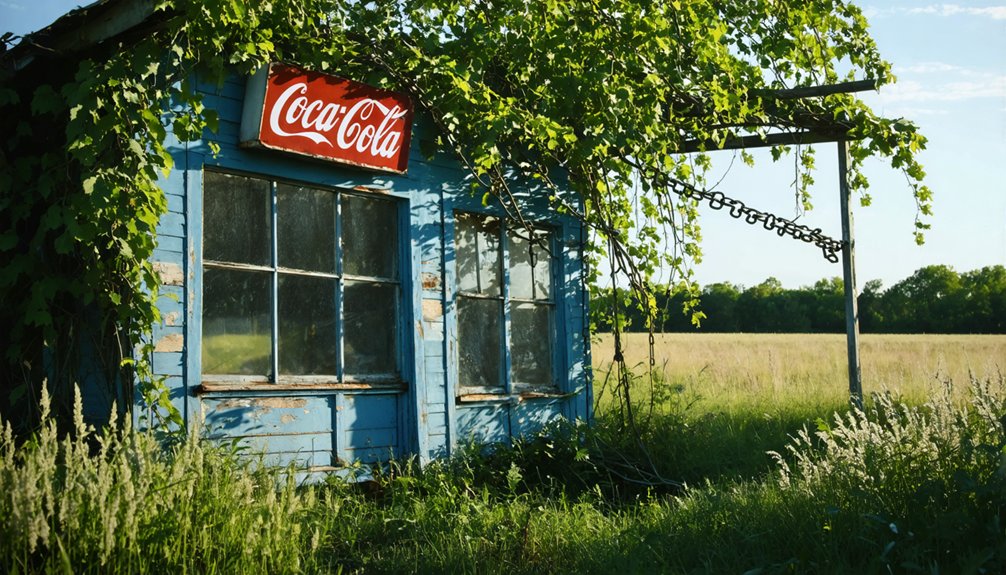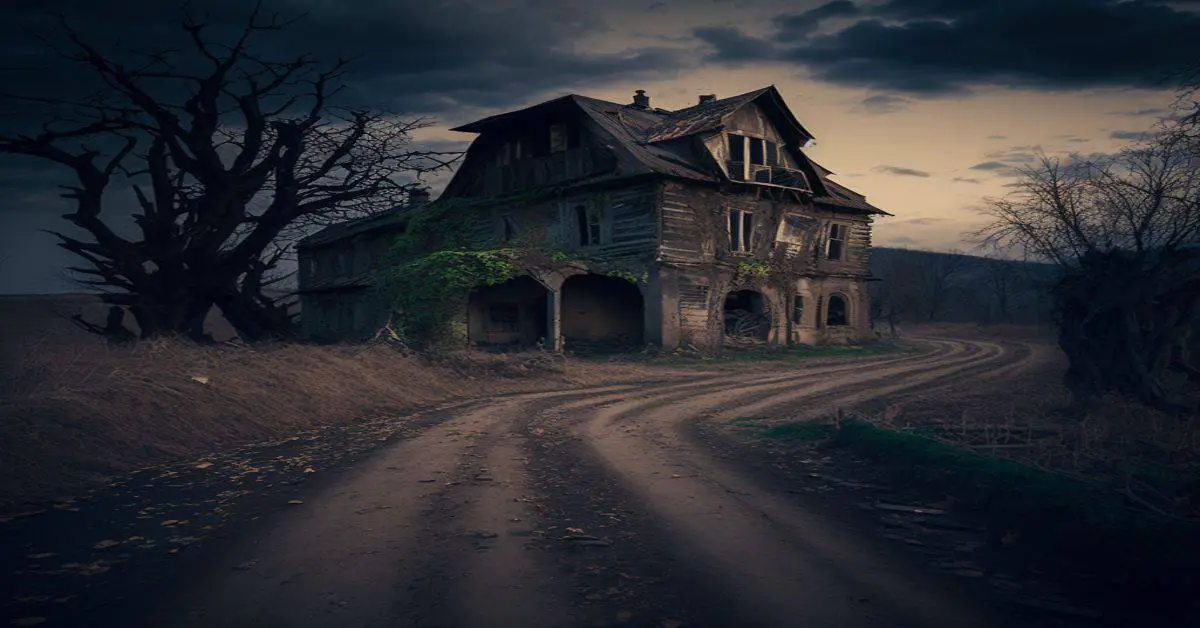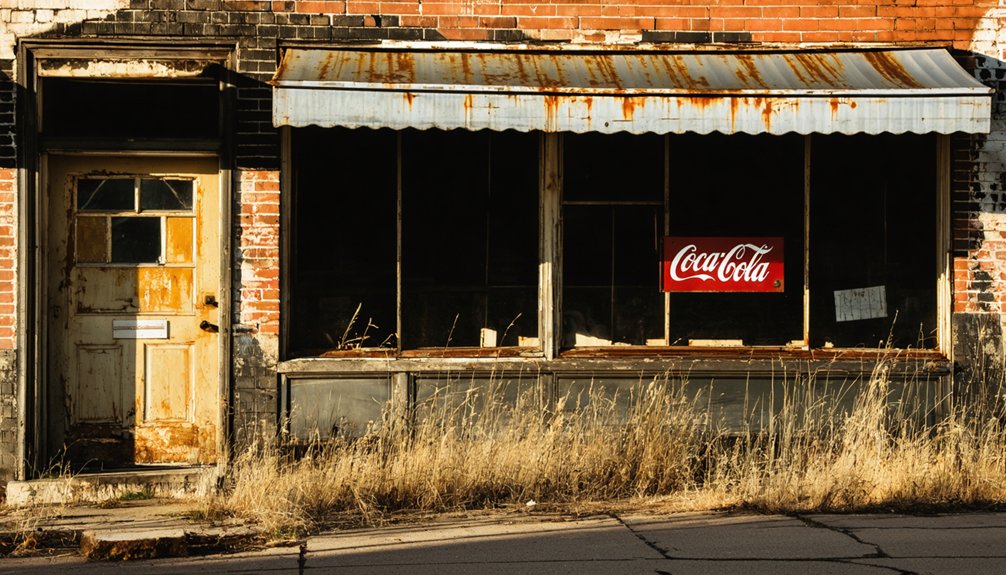You’ll find Riverview’s origins as an 1833 settlement along the Des Plaines River, where European immigrants transformed floodplain soils into farmland. The arrival of the Illinois and Wisconsin Railroad in 1854 sparked its growth into a bustling hub with five factories by the 1880s. The town’s decline began in the 1920s, leading to its absorption into Des Plaines in 1925. Today’s abandoned structures reveal a deeper story of Illinois’s vanished railroad communities.
Key Takeaways
- Riverview transformed from a thriving transportation hub to a ghost town after being absorbed into Des Plaines in 1925.
- Economic decline accelerated when railroad networks were replaced by highways and automobiles after World War II.
- The town’s dependence on a single industry made it vulnerable to economic downturns, leading to widespread business closures.
- Young residents left Riverview seeking opportunities elsewhere, causing demographic shifts and declining tax revenues.
- Few original buildings remain from Riverview’s peak period, with abandoned structures marking its transformation from bustling town to ghost town.
The Birth of a Railroad Settlement
As the Illinois and Wisconsin Railroad established its first stop in the Riverview area in 1854, this strategic location along major rail lines marked the beginning of a settlement that would soon become a bustling transit hub.
You’ll find that railroad innovation transformed this once-quiet area, as the Illinois Central Railroad’s Chicago-Cairo line completion in 1856 sparked unprecedented growth.
The settlement patterns that emerged reflected the era’s rapid expansion of rail infrastructure across Illinois. In 1836, the ambitious Illinois and Michigan Canal construction began, further establishing the region’s importance as a transportation corridor. The Aurora City Railway introduced streetcar service with mule-drawn cars in 1882, enhancing local transportation. By 1876, Riverview had grown enough to warrant its own post office and official incorporation as a village.
Railroad expansion brought vitality to Illinois towns like Riverview, transforming rural outposts into thriving communities with essential municipal services.
You can trace the community’s early development through its carefully planned features, including curvilinear roadways and thoughtfully positioned commercial buildings that supported both residents and railroad operations.
This transportation nexus would shape Riverview’s identity for generations to come.
Early Economic Foundations
While Chicago’s meteoric rise dominated the region’s narrative, Riverview carved out its own economic identity beginning in 1833 along the fertile banks of the Des Plaines River.
You’ll find that European immigrants established the settlement’s foundation through agricultural prowess, transforming the rich floodplain soils into productive farmland that fed Chicago’s growing population.
The community’s economic diversification emerged naturally as farming success spawned supporting industries. Local mills processed grain, blacksmiths forged tools, and small manufacturing operations took root along the riverbanks. The area’s development took a dramatic turn when William Schmidt established a local shooting range in 1879.
This community resilience showed in how Riverview adapted to regional demands, maintaining a mixed economy of farms, workshops, and modest factories. The area later became home to the famous Riverview Park that operated until 1967.
Though lacking mineral resources or major rail connections, the settlement’s river access and agricultural strength sustained its independence until its eventual absorption into Des Plaines.
Transportation and Trade Networks
If you’d explored Riverview in its heyday, you’d have witnessed a bustling transportation hub where interurban rail lines, streetcars, and the railroad converged to connect the town with Aurora, Chicago, and surrounding communities.
The town’s strategic position along rail routes established in 1859 enabled factories to receive raw materials and distribute finished goods, while interurban lines built after 1899 brought thousands of visitors to Riverview Park. Many of these interurban networks faced significant decline in the early 1930s as competition from automobiles and buses grew. The area’s industrial growth was marked by four factories operating by 1885, demonstrating the vital role transportation played in the town’s development.
River Trade Routes
The strategic location of Riverview along the Illinois River positioned it within one of North America’s most significant water transportation networks.
You’ll find that river navigation here was part of a complex system that connected the Great Lakes to the Mississippi River, a route first utilized by Native Americans and later expanded by French fur traders in the colonial period.
When the Illinois and Michigan Canal opened in 1862, you’d have seen a surge in commercial activity as it created a direct water route from Chicago to the Gulf of Mexico. Early canal traffic flourished with E.W. Gould’s boats operating through the Maples Packet Company.
Stretching 273 miles southwest across Illinois, the river provided an ideal corridor for transporting goods.
The river trade routes through Riverview carried millions of tons of agricultural products and other commodities, though this golden age of water transport wouldn’t last forever.
As railroads emerged in the late 19th century, they began to overshadow these historic waterways.
Railway Hub Development
Riverview’s transformation from a river port into a major railway hub began in 1859 when railroad expansion carved through the settlement, establishing new patterns of commerce and connectivity.
You’d find the Chicago, Aurora & Elgin Railroad’s “Great Third Rail” revolutionizing freight transportation and passenger service throughout the Fox River Valley region by the early 1900s. Similar to the Marietta-Cincinnati Railroad that served Moonville, these vital rail lines were essential for local commerce and connectivity.
The town’s strategic location made it an essential transfer point where:
- Large interurban cars from Chicago connected to local streetcars
- Agricultural and industrial goods flowed efficiently to major markets
- Summer excursionists traveled to Riverview Park by the thousands
Before extensive road networks emerged, these rail connections were your lifeline to the wider world, enabling Riverview’s growth as a vibrant transportation nexus until the post-WWII shift toward highways began the town’s decline.
The venture capitalist investments in the 1890s and early 1910s fueled rapid expansion of electric railway systems across the Midwest, transforming regional transportation.
Commerce Between Towns
During the mid-nineteenth century, you’d find a complex web of transportation networks linking Riverview to neighboring settlements through waterways, early roads, and eventually rail lines.
River commerce dominated the local economy, with steamboats regularly stopping to load agricultural products and unload manufactured goods. You could witness a bustling trade scene as farmers brought their harvests to local merchants who’d then ship via the Illinois River.
Trade dynamics shifted seasonally, with peak activity during harvest times. Ferry services played a vital role in connecting Riverview to settlements across the river, enabling year-round commerce despite weather challenges.
Local merchants diversified their offerings, trading not just agricultural goods but also coal and other natural resources extracted from nearby areas, creating a resilient economic network that sustained the region’s growth.
Life Along the River’s Edge

Settled along strategic transportation routes in 1833, Riverview carved out its existence between Oakton, River, Touhy, and Lee streets as both a farming community and industrial center.
While river ecology played a minimal role in the town’s development, the Illinois and Wisconsin railroad became the lifeline of community engagement and economic growth.
By the late 1880s, you’d have found a bustling town marked by:
- Five factories driving industrial progress
- A post office serving as a crucial communication hub
- Multiple residential streets teeming with workers’ families
Today, you’ll find few traces of this once-independent town since its absorption into Des Plaines in 1925.
The factories are gone, and only a handful of original houses remain on Deane Street and Circle Avenue, leaving the area mainly residential.
The Rise and Peak Years
You’ll find Riverview’s most significant growth period began with the 1859 railroad construction, which transformed the rural settlement into a bustling transportation hub for agricultural goods.
The town’s strategic location between major trade routes attracted industrial operations, with four factories establishing themselves by 1885.
Early Railroad Growth Era
The arrival of the Illinois and Wisconsin Railroad in fall 1854 marked Riverview’s transformation into a bustling rail hub, reflecting Illinois’ broader railway expansion of the 1850s.
You’d have witnessed unprecedented economic transformation as railroads rapidly connected the region to Chicago’s growing network, opening new opportunities for commerce and growth.
Key developments that shaped Riverview’s railroad expansion included:
- Massive capital investments from Eastern and European financiers
- Integration with Chicago’s emerging role as a central Midwest transportation hub
- Construction of branch lines and spurs serving local industries
The impact was revolutionary – you could now ship goods faster and cheaper than ever before.
This rail access positioned Riverview strategically within Illinois’ rapidly developing transportation system, fundamentally altering the town’s economic prospects and connecting its residents to distant markets.
Agricultural Trade Hub Development
Building upon its rail foundation, Riverview blossomed into a major agricultural trade center between 1876 and 1889. You’d have found five factories processing agricultural goods, with grain storage facilities and warehouses supporting robust crop distribution networks.
The town’s strategic location along the Illinois River and multiple rail lines created ideal conditions for seed commerce and bulk shipping operations. The infrastructure perfectly positioned Riverview to capitalize on the region’s shift from subsistence to commercial farming.
You could’ve witnessed hopper cars loaded with grain departing via the Wisconsin Central spur, while seed companies and agricultural suppliers established distribution points throughout the area. The town’s incorporation and post office enhanced these commercial operations, though proposed ventures like Columbia Steel Car Works and Riverview Shoe Company never materialized, hinting at the speculative nature of this boom period.
Industrial Operations Expand
During the early 1900s, Riverview’s industrial landscape underwent dramatic transformation as steel manufacturing operations spread outward from Chicago’s industrial core.
You’d have witnessed remarkable industrial innovation as Acme Steel opened its furnace plant in 1908, later merging with By Products Coke to form Interlake Steel.
The manufacturing evolution brought dramatic changes:
- Steel plants with integrated infrastructure, including a conveyor system spanning the Calumet River
- Coal mining operations that powered factories and reduced energy costs
- Enhanced transportation networks connecting rail, water, and canal systems
The town’s industrial might grew further when Safety Electric Company arrived in 1920, diversifying local manufacturing.
Jordan Manufacturing’s operations from 1964 to 1979 demonstrated Riverview’s sustained industrial significance, though many original facilities wouldn’t survive past the region’s eventual annexation by Des Plaines.
Forces Behind the Decline
Multiple interconnected factors contributed to Riverview’s transformation from a thriving community into an abandoned ghost town. When its primary industry faltered due to economic downturns, you’d have witnessed the rapid unraveling of the town’s economic foundation.
The lack of diverse industries left Riverview particularly vulnerable, as it had relied heavily on a single major employer. As businesses shuttered and jobs disappeared, demographic shifts accelerated when younger residents sought opportunities elsewhere.
This exodus created a devastating cycle – declining tax revenues led to deteriorating infrastructure and reduced services, which in turn drove more people away. Without sufficient funding to maintain basic amenities or attract new investments, Riverview’s once-bustling streets gradually emptied, leaving behind abandoned buildings as silent testimonies to its former liveliness.
Physical Remnants Today

Today’s visitors to Riverview’s former location will find scant evidence of the once-vibrant Illinois town. The physical remnants are limited to a handful of private homes along Deane Street and Circle Avenue, silent witnesses to the urban transformation that has swept through the area since its 1925 incorporation into Des Plaines.
The town’s historical footprint has largely vanished, with notable absences including:
Time has erased Riverview’s physical legacy, leaving behind empty spaces where a vibrant community once stood.
- All civic buildings, including the post office and fire station
- Industrial structures from the five factories that once operated here
- Railroad infrastructure that sparked the town’s initial growth
You’ll notice the original agricultural and industrial landscape has given way to modern suburban development.
No historical markers commemorate the site, and most of Riverview’s physical heritage has been erased through decades of redevelopment.
Historical Significance and Legacy
While Riverview’s physical structures have largely vanished, its historical significance lies in its role as a microcosm of 19th-century Illinois industrial development.
You’ll find that the town’s evolution from an 1833 settlement to a thriving industrial hub mirrors the broader transformation of the American Midwest during the Industrial Revolution.
The town’s historical impact extends beyond its industrial achievements. From its strategic railroad placement to its five factories, Riverview exemplified the economic opportunities that drew settlers westward.
Though its independent community identity dissolved when it merged with Des Plaines in 1925, Riverview’s legacy persists in historical records and local archives.
You’re witnessing a story that’s common to many Midwestern towns – one of rapid growth, industrial prosperity, and eventual transformation as economic patterns shifted.
Frequently Asked Questions
What Native American Tribes Originally Inhabited the Riverview Area Before Settlement?
You’ll find Native tribes of the Illiniwek Confederation, including the Cahokia, Kaskaskia, Michigamea, Peoria, and Tamaroa, held historical significance in this region before European settlement disrupted their presence.
Were There Any Notable Crimes or Outlaws Associated With Riverview?
You won’t find documented outlaw activities or notable crime history associated with this location. Available records show it was primarily focused on farming and industrial development rather than criminal enterprises.
What Happened to the Cemetery and Burial Grounds After Abandonment?
You’ll find no traditional cemetery to preserve at Riverview – it wasn’t a ghost town but an amusement park. Any burial needs were handled by Chicago’s existing cemeteries throughout its operation.
Did Any Famous Historical Figures Ever Visit or Stay in Riverview?
You won’t find records of celebrity sightings or historical figures visiting the town. Despite its industrial and railroad prominence, there’s no documented evidence of any famous personalities staying there.
What Natural Disasters, Besides Flooding, Impacted the Town’s Development and Decline?
Picture a town untouched by nature’s fury – you won’t find evidence of earthquake impact or tornado destruction here. Historical records show no major natural disasters besides flooding affected Riverview’s trajectory.
References
- https://www.youtube.com/watch?v=QAUXJrzZASw
- https://www.heraldtimesonline.com/story/lifestyle/home-garden/2021/01/15/some-illinois-ghost-towns/43846097/
- https://www.youtube.com/watch?v=fy3yJDBA5nI
- https://myfamilytravels.com/illinois-river-towns-locals-say-lost-their-soul/
- https://drloihjournal.blogspot.com/p/lost-towns-of-illinois-series.html
- https://sangamoncountyhistory.org/wp/14696/
- https://www.ghosttowns.com/states/il/riverviewillinois.html
- https://en.wikipedia.org/wiki/List_of_ghost_towns_in_Illinois
- https://www.riverside.il.us/568/The-History-of-Riverside
- https://drloihjournal.blogspot.com/2018/08/riverview-amusement-park-aurora-illinois-1899-1911fox-river-park-aurora-1911-1925.html



